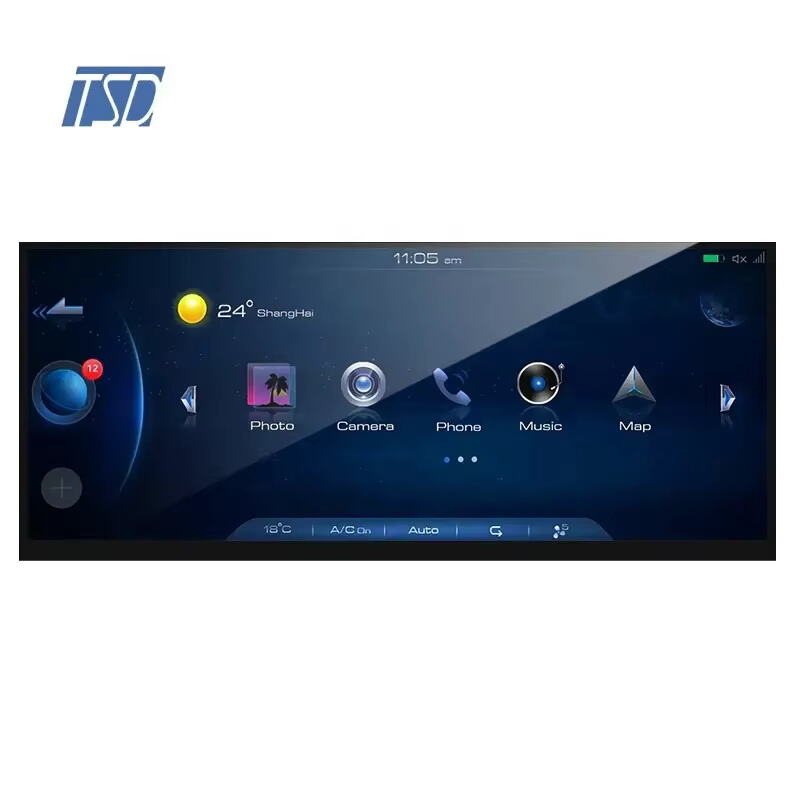Automotive LCD Durability Challenges in Extreme Environments
Impact of Vibration on LCD Performance
Road vibrations really take a toll on how long automotive LCD screens last and how well they work. Cars bouncing around different surfaces day after day causes problems for those display panels inside. We've seen data showing cars hit all sorts of vibration levels depending on where they drive, and this wears down the reliability of LCD performance over time. When driving over bumpy roads especially, pixels can actually come loose or the screen starts to flicker annoyingly. Many drivers report frustration when their dash displays start acting up because of too much shaking during regular commutes. Most of these troubles come back to poor design choices that don't properly protect against constant road vibrations affecting automotive LCD units. That's why manufacturers need to focus more on building tougher, longer lasting LCD solutions for vehicles if they want satisfied customers on the road.
Thermal Stress in Automotive Applications
Car LCD screens deal with serious heat problems because vehicles operate in all kinds of weather extremes. The constant temperature changes create expansion and contraction in key parts of the display, including the glass and liquid crystal layers. After many cycles of this stress, failures start happening, which reduces how reliable these automotive displays actually are. Testing shows that when LCDs go through both hot and cold temperature extremes repeatedly, they tend to fail more often than usual. Components might crack or stop working properly after being exposed to prolonged thermal stress, so engineers need better ways to make these displays withstand such conditions. Solving these issues matters a lot if we want car LCDs to last longer and work well no matter what kind of climate they're in.
Engineering Solutions for Vibration Resistance
Ruggedized Display Design Principles
Automotive LCD screens need rugged design features if they're going to survive all those road vibrations without breaking down. Most manufacturers focus on making their displays tougher by using better materials and newer tech solutions. Take reinforced glass panels and flexible circuit boards as common fixes for mechanical stress issues. These components really cut down on pixel problems and keep the screen working properly over time. Industry data suggests that when LCDs get built with these rugged specs, they perform much better in actual driving conditions. Vibrations just don't affect them as badly anymore, so reliability stays high even on rough roads. Looking at how cars are used today, it makes sense why manufacturers keep improving these durability factors. After all, nobody wants their dashboard display cracking during a bumpy commute or getting damaged while off-roading.
Advanced Mounting Techniques for Shock Absorption
Mounting methods are just as important as tough materials when it comes to protecting automotive LCD screens from shocks. Modern approaches let manufacturers install displays that stand up better to bumps and rough roads. For starters, passive mounts like rubber gaskets work pretty well for basic protection against vibrations because they flex with movement. But there's another option too - active mounting systems which actually adapt to different levels of shaking. These smart systems adjust their resistance depending on how intense the vibrations get. Real world testing shows that proper mounting really makes a difference in how long these screens last before needing replacement. The mechanical stress gets reduced substantially, so damage happens less often. When engineers take the time to pick the right mounting solution for each vehicle application, they end up with much more durable and reliable display systems across all types of cars and trucks.
Wide-Temperature Adaptation Technologies
Material Innovations for Thermal Stability
Knowing how different materials affect thermal stability makes all the difference in improving automotive LCD performance. Car manufacturers have started using things like polymer composites and special coatings to protect against damage across various temperatures. These components really matter because they keep screens clear even when outside temps swing wildly. Take polymer composites for instance they actually prevent cracking issues that happen when temperatures change rapidly. Studies show these materials can make a big impact on how well the displays work while still showing crisp images. Drivers end up with reliable screens no matter if it's 110 degrees Fahrenheit in summer or below zero during winter months. Some companies report their customers notice fewer problems with screen readability after switching to these newer material solutions.
Dynamic Backlight Control Systems
Backlight control systems that adapt dynamically are changing how LCDs perform across different temperatures. When it gets cold outside or bright inside a car, these smart systems tweak the screen brightness so displays stay clear and readable. The advantages go beyond better visibility too. Cars equipped with this tech actually consume less power because the system only uses what's needed for current conditions. Tests show that screens last longer when using dynamic adjustment methods, which matters a lot for car manufacturers looking to build reliable products. Automakers have started incorporating these advanced features into their dashboards and infotainment systems, helping them deliver quality visuals while keeping fuel consumption down something green-minded buyers definitely appreciate.

Testing Standards for Automotive-Grade LCDs
Vibration Resistance Certification Protocols
Getting automotive LCDs to last requires proper vibration resistance certification. These certifications basically tell us whether an LCD screen can handle what happens inside a car over time. Tests check how well screens resist shocks and keep working despite constant shaking from roads and engine movement. Big names like ISO and SAE create most of these standards, and car part makers need to follow them if they want their products approved. Take ISO 16750-3 for example it lays out exactly how to test electrical parts so we know they won't fail when exposed to normal vehicle vibrations day after day. Screens passing these tough tests end up in places where reliability matters most think GPS units or digital dashboards. The real value? Certified displays give peace of mind knowing they'll keep functioning properly even when subjected to all sorts of rough treatment during regular driving.
Temperature Cycling Validation Methods
Getting a handle on temperature cycling validation methods matters a lot when evaluating how long automotive LCDs will last and work properly. Basically, what happens is manufacturers put these screens through extreme hot and cold conditions similar to what they'd experience inside cars during different seasons. The actual testing involves heating up and then cooling down the displays multiple times to see how they handle expansion and contraction stresses. For an LCD to pass these tests, it needs to stay clear and functional after hundreds of these cycles without showing cracks or other damage. Recent changes in industry standards have pushed for better designs that can stand up to temperature swings. We've seen real improvements come out of this testing approach too – things like stronger protective coatings and redesigned internal components. These advancements mean today's car displays are much tougher than before, handling everything from desert heatwaves to Arctic winters without breaking down.
FAQ
What are the main challenges automotive LCDs face?
Automotive LCDs often face challenges like vibrations from road conditions and thermal stress due to extreme weather, impacting performance and durability.
How can vibrations affect automotive LCDs?
Vibrations can lead to pixel failures, screen flickering, and potentially compromised display integrity due to mechanical stress.
Why is thermal stress a concern for automotive LCDs?
Thermal stress can cause LCD components to expand and contract, leading to potential failures and reduced reliability over time.
What engineering solutions are available to improve LCD durability?
Solutions include ruggedized display designs, advanced mounting techniques for shock absorption, and material innovations for better thermal stability.
How do dynamic backlight control systems help automotive LCDs?
These systems optimize visibility and energy efficiency by adjusting backlight intensity according to ambient conditions.
What future trends are expected in automotive display technology?
Future trends include the integration of MicroLED advancements and smart thermal management systems to enhance performance and efficiency.
Table of Contents
- Automotive LCD Durability Challenges in Extreme Environments
- Engineering Solutions for Vibration Resistance
- Wide-Temperature Adaptation Technologies
- Testing Standards for Automotive-Grade LCDs
-
FAQ
- What are the main challenges automotive LCDs face?
- How can vibrations affect automotive LCDs?
- Why is thermal stress a concern for automotive LCDs?
- What engineering solutions are available to improve LCD durability?
- How do dynamic backlight control systems help automotive LCDs?
- What future trends are expected in automotive display technology?




